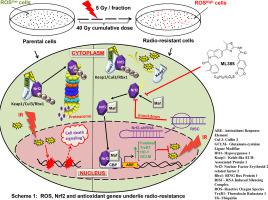Journal of Photochemistry and Photobiology B: Biology ( IF 5.4 ) Pub Date : 2020-11-13 , DOI: 10.1016/j.jphotobiol.2020.112080 Babita Singh , Raghavendra S. Patwardhan , Sundarraj Jayakumar , Deepak Sharma , Santosh K. Sandur

|
Differential inherent and acquired radioresistance of human lung cancer cells contribute to poor therapeutic outcome and tumor recurrence after radiotherapy. Inherent radioresistance of lung cancer cells is known to be associated with ROSLow cancer stem cells (CSCs). However, mechanism of acquired radioresistance in lung cancer cells is poorly understood. Here, we exposed human lung cancer cells (A549) to a cumulative dose of 40Gy and allowed the radioresistant (RR) survivors to divide and form macroscopic colonies after each fraction of 5Gy dose. The RR subline exhibited enrichment of cytosolic ROSHigh cells without specific increase in mitochondrial ROS levels. We found a concomitant increase in the expression of redox regulatory transcription factor Nrf2 and its dependent antioxidant genes in RR cells and cell cycle delay as compared to parental cells. The treatment of RR cells with Nrf2 inhibitor resulted in decreased clonogenic survival indicating their addiction to Nrf2 for metabolic adaptations under high levels of cytosolic ROS. A causal role of inherent ROS levels in conferring radioresistance was established by sorting ROSHigh and ROSLow populations from parental and RR cells. It was observed that ROSHigh population from both parental and RR cells exhibited radioresistance as observed by clonogenic assay. Interestingly, ROSHigh population of cells exhibited higher levels of cellular thiols in both parental and RR cells. Thus, our observations highlight presence of a novel subpopulation in lung cancer cells, which exhibits radioresistance by maintaining ‘oxidative stress’ and Nrf2 dependent metabolic adaptations. We also posit Nrf2 pathway as a druggable target for radiosensitization of RR A549 cells.
中文翻译:

氧化应激相关的代谢适应调节人肺癌细胞的抗辐射性
人肺癌细胞固有的和获得的不同的放射抗性导致放射治疗后不良的治疗结果和肿瘤复发。已知肺癌细胞的固有放射抗性与ROS低癌干细胞(CSC)相关。然而,人们对肺癌细胞获得性放射抗性的机制了解甚少。在这里,我们将人类肺癌细胞(A549)暴露于40Gy的累积剂量下,并在每5Gy剂量后允许抗辐射(RR)幸存者分裂并形成宏观菌落。RR亚系表现出丰富的胞浆ROS高线粒体ROS水平没有特定增加的细胞。我们发现与亲代细胞相比,RR细胞中氧化还原调节转录因子Nrf2及其依赖的抗氧化剂基因的表达同时增加,并且细胞周期延迟。用Nrf2抑制剂处理RR细胞会导致克隆形成存活期降低,这表明它们在高水平胞质ROS的作用下会因代谢适应而沉迷于Nrf2。通过从亲代细胞和RR细胞中筛选出ROS高和ROS低种群,可以确定固有ROS水平在赋予抗辐射性中的因果作用。观察到,通过克隆形成测定观察到,来自亲代细胞和RR细胞的ROS高群体均显示出放射抗性。有趣的是,ROS高细胞群在亲代细胞和RR细胞中均表现出较高水平的细胞硫醇。因此,我们的观察结果突出显示了肺癌细胞中存在一个新的亚群,该亚群通过维持“氧化应激”和依赖Nrf2的代谢适应而表现出放射抗性。我们还将Nrf2途径作为RR A549细胞放射增敏的可药物治疗靶点。


























 京公网安备 11010802027423号
京公网安备 11010802027423号